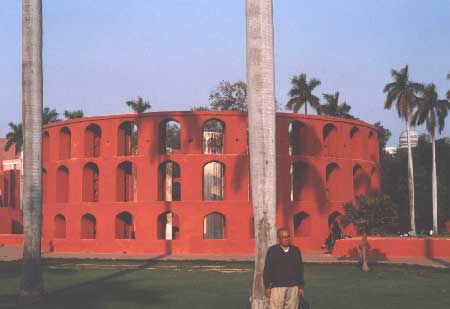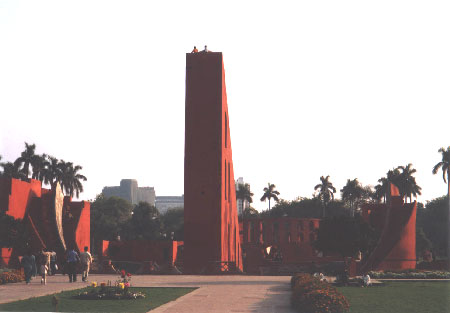|
|
Venus2004.org
> Files
1°) Introduction
Worldwide educational activities related to the Transit of Venus, are involving students in measurement of the Radius of the Earth, the maximum elongation (apparent angular distance from the Sun, as seen from the Earth) of Venus, refining observational methods for accurate timing, locating one’s Geography and so on – all ingredients needed to finally use the Transit of Venus observations towards a determination of the Astronomical Unit1. This seemed an exciting opportunity to make use of historical Jantar Mantar Observatory at Delhi – use instruments like the Jayaprakas and Ram Yantra at this observatory – which are designed for making celestial co-ordinate measurements of objects in the sky.  Jantar Mantar © Nehru Planetarium, New Delhi, India. The observatory built by Swai Jai Singh of Amber, has been in disuse since the 18th century. The Delhi Observatory is thought to have been completed in the year 1724, used for a brief period after the construction and have remained virtually in disuse since Jai Singh’s death. One reason for this state of matter may have been vandalisation of the Observatory immediately following his death. Another important reason for this could also have been from the very anachronicity of the making of these instruments – they were built at a time when smaller instruments with micrometers and verniers and optical instruments with telescopic sights were being found by European Astronomers to yield the best observational results compared to massive masonry instruments. While Jai Singh (with a firm belief in the superiority of massive masonry structures) wished to use the instruments to make accurate celestial co-ordinate measurements and hence improve ephemeris tables for Astronomical calculations, one of his aims in the construction of these massive instruments had also been that anyone (not necessarily an Astronomer) interested in making celestial co-ordinate measurements should find it easy to do so, using these instruments. It was precisely this purpose which seemed to have been achieved again when it was possible to train students and visitors to the Delhi Jantar Mantar, on the 29th of March 2004, to make celestial co-ordinate measurements using the Jaya Prakas and Ram Yantra instruments. Most public visitors are usually befuddled by the twin hemispherical bowls of the Jayaprakas and the imposing cylindrical buildings of the twin Ram Yantra at the Delhi Jantar Mantar. These, however, are the very instruments that allow anyone - including school students, to make easy measurements of the celestial co-ordinates of objects in the sky. The measurements on the 29th of March 2004 and in the week following that, were confined to obtaining local celestial co-ordinates of the Sun, Moon, planets and some bright stars – their Altitude (perpendicular height from the Horizon to the object) and Azimuth (the location, along the Horizon, measured from the North towards the East, of such a perpendicular dropped from the object to the Horizon) at different times. The Altitude and Azimuth measurements of the Sun and Venus on the 29th of March, were used for obtaining the elongation of Venus on this date.  Jantar Mantar © Nehru Planetarium, New Delhi, India. The Ram Yantra is meant precisely for the observation of Altitude and Azimuth of the Sun, planets and stars. The Jayaprakas can also measure these co-ordinates, as well as the more global Equatorial co-ordinates. |
|
© 2003-2006 Futura-Sciences.com. All rights reserved.
Indexator - Comparateur de prix - Revue de Presse
